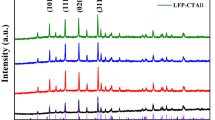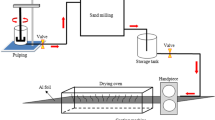Abstract
In this study, sub-micrometer LiFePO4 particles with high purity and crystallinity were synthesized using supercritical hydrothermal method as the cathode material for lithium ion batteries. Experimental results show that templates and calcination time have significant impacts on the purity, particle size and morphology of LiFePO4 particles. The as-prepared LiFePO4 particles using polyvinyl pyrrolidone (PVP) template with additional one hour calcination at 700°C exhibit characteristics of good crystallinity, uniform size distribution, high capacity and cycling performance. The specific discharge capacities of 141.2 and 114.0mA·h/g were obtained at the charge/discharge rates of 0.1 and 1.0 C, respectively. It retained 96.0% of an initial capacity after 100 cycles at 1.0 C rate. The good electrochemical performance of the as-synthesized material is attributed to the synergistic factors of its reasonable particle size and surface areas and high crystallinity.
Similar content being viewed by others
References
Padhi A K, Nanjundaswamy K S, Goodenough J B. Phospho-olivines as positive-electrode materials for rechargeable lithium batteries [J]. Journal of The Electrochemical Society, 1997, 144(4): 1188–1194.
Aimable A, Aymes D, Bernard F, et al. Characteristics of LiFePO4 obtained through a one step continuous hydrothermal synthesis process working in supercritical water [J]. Solid State Ionics, 2009, 180: 861–866.
Chung S Y, Bloking J T, Chiang Y M. Electronically conductive phospho-olivines as lithium storage electrodes [J]. Nature Materials, 2002, 1(2): 123–128.
Prosini P P, Lisi M, Zane D, et al. Determination of the chemical diffusion coefficient of lithium in LiFePO4 [J]. Solid State Ionics, 2002, 148(1-2): 45–51.
Yamada A, Chung S C, Hinokuma K. Optimized LiFePO4 for lithium battery cathodes [J]. Journal of The Electrochemical Society, 2001, 148: A224–A229.
Takahashi M, Tobishima S, Takei K, et al. Characterization of LiFePO4 as the cathode material for rechargeable lithium batteries [J]. Journal of Power Sources, 2001, 97–98: 508–511.
Prosini P P, Carewska M, Scaccia S, et al. A new synthetic route for preparing LiFePO4 with enhanced electrochemical performance [J]. Journal of The Electrochemical Society, 2002, 149: A886–A890.
Arnold G, Garche J, Hemmer R, et al. Fineparticle lithium iron phosphate LiFePO4 synthesized by a new low-cost aqueous precipitation technique [J]. Journal of Power Sources, 2003, 119–121: 247–251.
Oh S W, Myung S T, Bang H J, et al. Nanoporous structured LiFePO4 with spherical microscale particles having high volumetric capacity for lithium batteries [J]. Electrochemical and Solid-State Letters, 2009, 12(9): A181–A185.
Wang G X, Bewlay S, Yao J, et al. Characterization of LiM xFe1−x PO4 (M = Mg, Zr, Ti) cathode materials prepared by the sol-gel method [J]. Electrochemical and Solid-State Letters, 2004, 7(12): A503–A506.
Adschiri T, Hakuta Y, Sue K, et al. Hydrothermal synthesis of metal oxide nanoparticles at supercritical conditions [J]. Journal of Nanoparticle Research, 2001, 3: 227–235.
Lee J, Teja A S. Characteristics of lithium iron phosphate (LiFePO4) particles synthesized in subcritical and supercritical water [J]. Journal of Supercritical Fluids, 2005, 35: 83–90.
Hong S A, Kim S J, Kim J, et al. Small capacity decay of lithium iron phosphate (LiFePO4) synthesized continuously in supercritical water: Comparison with solid-state method [J]. Journal of Supercritical Fluids, 2011, 55: 1027–1037.
Doherty C M, Caruso R A, Smarsly B M, et al. Colloidal crystal templating to produce hierarchically porous LiFePO4 electrode materials for high power lithium ion batteries [J]. Chemistry of Materials, 2009, 21: 2895–2903.
Author information
Authors and Affiliations
Corresponding author
Additional information
Foundation item: the Fundamental Research Funds for the Central Universities of China (No. DUT11NY08)
Rights and permissions
About this article
Cite this article
Liu, Xw., Wei, H., Deng, Yf. et al. Synthesis of sub-micrometer lithium iron phosphate particles using supercritical hydrothermal method for lithium ion batteries. J. Shanghai Jiaotong Univ. (Sci.) 17, 517–522 (2012). https://doi.org/10.1007/s12204-012-1317-6
Received:
Published:
Issue Date:
DOI: https://doi.org/10.1007/s12204-012-1317-6




